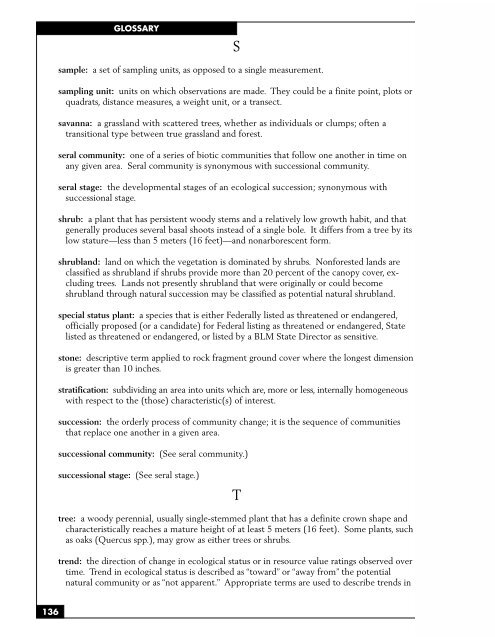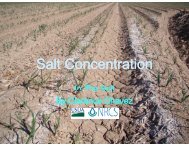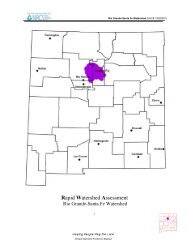SAMPLING VEGETATION ATTRIBUTES - New Mexico NRCS - US ...
SAMPLING VEGETATION ATTRIBUTES - New Mexico NRCS - US ...
SAMPLING VEGETATION ATTRIBUTES - New Mexico NRCS - US ...
You also want an ePaper? Increase the reach of your titles
YUMPU automatically turns print PDFs into web optimized ePapers that Google loves.
136<br />
GLOSSARY<br />
sample: a set of sampling units, as opposed to a single measurement.<br />
S<br />
sampling unit: units on which observations are made. They could be a finite point, plots or<br />
quadrats, distance measures, a weight unit, or a transect.<br />
savanna: a grassland with scattered trees, whether as individuals or clumps; often a<br />
transitional type between true grassland and forest.<br />
seral community: one of a series of biotic communities that follow one another in time on<br />
any given area. Seral community is synonymous with successional community.<br />
seral stage: the developmental stages of an ecological succession; synonymous with<br />
successional stage.<br />
shrub: a plant that has persistent woody stems and a relatively low growth habit, and that<br />
generally produces several basal shoots instead of a single bole. It differs from a tree by its<br />
low stature—less than 5 meters (16 feet)—and nonarborescent form.<br />
shrubland: land on which the vegetation is dominated by shrubs. Nonforested lands are<br />
classified as shrubland if shrubs provide more than 20 percent of the canopy cover, excluding<br />
trees. Lands not presently shrubland that were originally or could become<br />
shrubland through natural succession may be classified as potential natural shrubland.<br />
special status plant: a species that is either Federally listed as threatened or endangered,<br />
officially proposed (or a candidate) for Federal listing as threatened or endangered, State<br />
listed as threatened or endangered, or listed by a BLM State Director as sensitive.<br />
stone: descriptive term applied to rock fragment ground cover where the longest dimension<br />
is greater than 10 inches.<br />
stratification: subdividing an area into units which are, more or less, internally homogeneous<br />
with respect to the (those) characteristic(s) of interest.<br />
succession: the orderly process of community change; it is the sequence of communities<br />
that replace one another in a given area.<br />
successional community: (See seral community.)<br />
successional stage: (See seral stage.)<br />
T<br />
tree: a woody perennial, usually single-stemmed plant that has a definite crown shape and<br />
characteristically reaches a mature height of at least 5 meters (16 feet). Some plants, such<br />
as oaks (Quercus spp.), may grow as either trees or shrubs.<br />
trend: the direction of change in ecological status or in resource value ratings observed over<br />
time. Trend in ecological status is described as “toward” or “away from” the potential<br />
natural community or as “not apparent.” Appropriate terms are used to describe trends in




